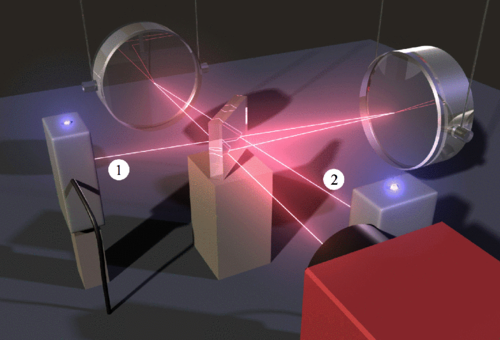August 10, 2015 report
Best of Last Week – Neutrino oscillations, photo of the moon and Earth and neuro impact of body posture during sleep

(Phys.org)—It was another good week for physics as one researcher, Roman Schnabel, a professor at the Max Planck Institute for Gravitational Physics, unveiled a plan for entangling massive objects—specifically two 0.1 kg mass mirrors—if the idea can be carried out in an experiment, it would represent a huge leap forward in entangling objects. Also, a team with the University of California cooled the world's quietest gas to allow them to hear faint quantum effects—at just a billionth of a degree above absolute zero it had the lowest entropy ever recorded.
Another team working with the NOvA Fermilab experiment saw neutrinos change over 500 miles—allowing the team to measure oscillations of the tiny particles, and in the process prove that the detector built to study them actually works as planned. Also, another group of four researchers from the U.K., Singapore, Australia and Italy theorized that faster battery charging may be had by using a quantum battery—via energy stored as qubit quantum states.
There was important space news as well, as one team of astronomers studying data from the Kepler Observatory discovered a tenth transiting "Tatooine"—where a planet orbits two stars. Also, a team of Hungarian and US researchers announced that they had found the largest feature in the universe—a ring of galaxies 5 billion light years across. And from a million miles away, a NASA camera showed the moon crossing the face of Earth—which showed its lighted "dark" side.
In other news, a team of researchers working in Singapore asked, can genes make us liberal or conservative? They conducted a study that included surveying 1,771 university students and found evidence that suggested genetics might play a role in our political leanings—more specifically, they found a gene variant that appeared to be linked to contributing to liberal versus conservative views. And a King's college study offered the first genetic analysis of people with extremely high intelligence—they found a genetic difference in the top 0.03 per cent of intelligent people.
And finally, if you have been worrying about developing a neurological disease, there may be something you can do to reduce your chances—sleep on your side. A team of researchers with Stony Brook University found evidence that suggests physical positioning during slumber can impact the body's ability to remove unneeded material in the brain. It was all part of a study looking into the question: could body posture during sleep affect how your brain clears waste?
© 2015 Phys.org





















